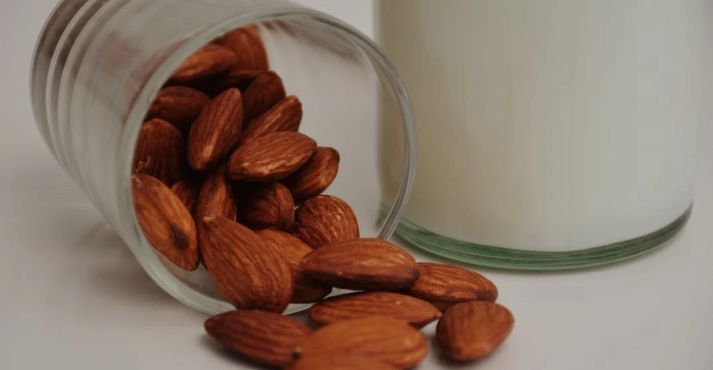Plant-based dairy alternatives have been making waves in the culinary world, and their popularity continues to soar.
In this article, we’ll embark on a journey through the domain of dairy substitutes. We’ll explore the diverse range of alternatives available, uncover their unique benefits, and discover how they can seamlessly fit into various recipes.
Whether you’re lactose intolerant, following a vegan lifestyle, or simply curious about non-dairy options, this exploration of milk alternatives and vegan-friendly dairy will pique your interest and expand your culinary horizons. Let’s dive in.
What Are Plant-Based Dairy Alternatives?

Plant-based dairy alternatives, also known as dairy substitutes or vegan dairy, are ingenious creations that serve as alternatives to traditional dairy products.
These alternatives are specifically designed to cater to individuals who are lactose intolerant, following a vegan lifestyle, or seeking healthier dietary choices.
Rather than relying on animal-based ingredients, these non-dairy options harness the goodness of plants like nuts, seeds, soy, oats, and more to mimic the texture and taste of traditional dairy.
They serve the same purpose in recipes, allowing you to enjoy your favorite dishes without compromising flavor or nutrition.
As we delve into this topic, we’ll explore the vast array of milk alternatives and vegan-friendly dairy options, each offering a unique twist on dairy-free indulgence.
Types of Plant-Based Dairy Alternatives

The world of plant-based dairy alternatives is diverse, offering many options that mirror traditional dairy products. Let’s explore the main categories and how each type is crafted to provide delicious and dairy-free alternatives.
Plant-Based Milk Alternatives: These alternatives to cow’s milk come in various forms, including Almond milk, soy milk, oat milk, and coconut milk. They are typically made by blending the ingredients with water and straining the solids.
Plant-Based Yogurt Options: Dairy-free yogurt has grown in popularity, with options such as soy yogurt, almond yogurt, and coconut yogurt becoming staples for those seeking vegan-friendly choices. These yogurts are typically made by fermenting plant-based milk alternatives with probiotics, resulting in a creamy and tangy yogurt experience.
Non-Dairy Cheese: Vegan cheese has come a long way in replicating the texture and flavor of traditional cheese varieties. Cashew cheese is a popular choice made by blending cashews with various seasonings and cultures. Other options include almond-based, soy-based, and coconut-based cheeses.
Plant-Based Milk Alternatives

Plant-based milk alternatives have become a staple in the diets of many, offering a wealth of options to suit various tastes and dietary needs.
Let’s look at four popular choices: almond milk, soy milk, oat milk, and coconut milk, exploring their nutritional profiles, taste, and versatile culinary applications.
- Almond Milk: almond milk is known for its mild, slightly nutty flavor. It’s a good source of vitamin E and typically lower in calories than cow’s milk. Almond milk is excellent for cereals, coffee, smoothies, and baking. Its delicate taste complements a wide range of dishes.
- Soy Milk: soy milk is rich in protein and often fortified with essential nutrients like calcium and vitamin D. It has a neutral flavor, making it a versatile option for sweet and savory recipes. Soy milk is a suitable replacement for cow’s milk in cooking and baking.
- Oat Milk: Its creamy texture and natural sweetness have gained popularity. It’s often fortified with calcium and vitamin D. Oat milk is a fantastic addition to coffee, as it froths well, creating a creamy latte or cappuccino. It’s also a delightful choice for cereal and baking.
- Coconut Milk: Its rich coconut taste imparts a tropical flair to dishes. It’s a good source of healthy fats often used in Asian and tropical cuisines. Coconut milk works well in curries, soups, and desserts, lending a distinct coconut aroma.
Each of these dairy-free milk options brings a unique flavor and nutritional profile. Whether lactose intolerant, vegan, or simply looking to diversify your culinary experiences, these plant-based milk alternatives offer a delicious and nutritious path to explore.
Plant-Based Yogurt Alternatives
Plant-based yogurt alternatives have transformed the dairy-free landscape, offering many flavors and textures.
Let’s dive into almond, coconut, and soy yogurt, uncovering how they are made and sharing tips to help you choose the best options for your preferences.
- Almond Yogurt: Almond Yogurt is crafted by blending almond milk with probiotics and often thickening agents like tapioca starch. It boasts a creamy texture and a subtly nutty flavor. Look for options with minimal added sugars and live active cultures for the most beneficial probiotic content.
- Coconut Yogurt: Coconut Yogurt is made from coconut milk and probiotics. It’s known for its luscious, tropical taste and creamy consistency. Ensure your choice contains live cultures, and opt for unsweetened or lightly sweetened versions to control sugar intake.
- Soy Yogurt: Soy Yogurt is created by fermenting soy milk with probiotics, resulting in a creamy and protein-rich alternative. Check for varieties with added calcium and vitamin D. Like other plant-based yogurts, seek options with live cultures for gut health benefits.
When selecting the best plant-based yogurt alternatives, consider flavor preferences, dietary needs, and nutritional content.
Be mindful of added sugars, as some products may contain more sweeteners than others. Live cultures are a plus, as they offer probiotic benefits similar to traditional yogurt.
Whether you have it by itself, mix it with fruits, or blend it into smoothies, plant-based yogurt is a tasty and dairy-free option for your cooking and eating choices.
Plant-Based Cheese Alternatives

Plant-based cheese alternatives offer a flavorful departure from traditional dairy cheese, with various options to explore.
Let’s delve into nut-based and soy-based alternatives, uncovering their textures, flavors, and how they can be incorporated into various dishes.
- Nut-Based Cheese: Nut-based cheese options, such as those made from almonds or cashews, are celebrated for their creamy textures and rich, nutty flavors. They are often crafted by blending soaked nuts with cultures and seasonings. These cheeses are versatile and can be sliced for sandwiches, grated on pasta, or spread on crackers for a dairy-free snack.
- Soy-Based Cheese: Soy-based cheese, derived from soybeans, offers a mild and neutral taste with a texture similar to dairy cheese. These versatile cheeses work well in melting applications, making them suitable for pizzas, quesadillas, and grilled cheese sandwiches.
Plant-based cheese Alternatives, whether nut-based or soy-based, provide options for those seeking vegan or cheese substitutes.
Their diverse textures and flavors add a delightful twist to everyday and gourmet dishes, making them valuable to dairy-free and plant-based diets.
Cooking and Baking with Plant-Based Alternatives
Cooking with plant-based alternatives opens up a world of delicious possibilities, and baking with non-dairy ingredients can be equally exciting. Here, we’ll provide practical advice, recipe ideas, and handy substitution tips for traditional dairy ingredients.
1. Practical Tips:
- When using plant-based milk in cooking or baking, choose the one that best complements the recipe. For instance, almond milk works well in desserts, while soy milk’s neutral flavor makes it versatile for most recipes.
- Experiment with plant-based fats, like coconut oil or vegan butter, to achieve your dishes’ desired texture and flavor.
- Non-dairy yogurt can be an excellent replacement for traditional yogurt in both sweet and savory recipes.
2. Recipe Ideas:
- Make a creamy pasta sauce using cashew cream instead of heavy cream for a luscious, dairy-free Alfredo.
- Bake a batch of vegan chocolate chip cookies using flaxseed or chia seed gel as an egg substitute.
- Explore vegan cheese alternatives for a melty, dairy-free delight in your pizza-making adventures.
3. Substitution Tips:
- For recipes calling for buttermilk, you can create a dairy-free version by adding a tablespoon of vinegar or lemon juice to your plant-based milk of choice and letting it sit for a few minutes.
- It can work wonders in recipes that require cream, coconut cream, or a blend of silken tofu and plant-based milk.
- When a recipe calls for cheese, consider nut-based cheeses or nutritional yeast for that cheesy flavor.
- Cooking and baking with plant-based dairy alternatives doesn’t mean compromising on taste or texture. With the right tips and creativity, you can create delectable vegan dishes and treats that everyone will enjoy.
Considerations and Challenges
Exploring plant-based dairy alternatives comes with several considerations and challenges that are important to remember as you navigate this culinary landscape. Let’s delve into these factors to help you make informed choices.
1. Taste Variations in Non-Dairy:
It’s essential to acknowledge that the taste of plant-based dairy alternatives may vary from their dairy counterparts.
Different nut or soy-based products can have unique flavor profiles that may require some adjustment if you’re accustomed to traditional dairy.
Experimenting with different brands and flavors can help you find what suits your palate.
2. Allergic Reactions to Plant-Based:
While plant-based dairy alternatives are generally considered safe, being aware of potential allergies is crucial.
Nut-based products, for example, can pose a risk to individuals with nut allergies. Always check product labels for allergen information and consult a healthcare professional with concerns.
3. Reading Product Labels:
Reading product labels is a critical step in ensuring that you’re selecting the suitable plant-based dairy alternative for your dietary needs.
Look for labels indicating that the product suits vegans or those with specific allergies. Also, pay attention to added sugars or additives that may be present.
4. Sourcing Plant-Based Products:

Depending on your location, Finding various plant-based dairy alternatives can sometimes be challenging. Consider exploring local health food stores and online retailers or making your plant-based options at home.
Navigating the world of plant-based dairy alternatives requires careful consideration of your taste preferences, potential allergies, and a commitment to reading product labels.
By doing so, you can enjoy the benefits of these alternatives while making choices that align with your dietary needs and values.
Taste Variations and Allergies
Regarding plant-based dairy alternatives, taste variations, and potential allergies are essential factors to consider. Here, we’ll address these aspects and provide tips to help you choose options that align with your preferences and dietary restrictions.
1. Taste Differences in Non-Dairy:
Plant-based alternatives can exhibit a wide range of taste profiles. Almond milk may have a subtle nutty flavor, while coconut yogurt can offer a tropical twist.
Consider sampling different options and brands to find the right fit for your palate. Experimenting with various flavors and types can lead you to the ones you enjoy the most.
2. Allergies to Plant-Based:
While plant-based dairy alternatives are generally allergen-friendly, some individuals may have specific allergies. Nut-based products, for instance, can pose a risk to those with nut allergies.
To ensure safety, carefully read product labels for allergen information. Opt for allergen-free alternatives when necessary, such as soy or oat-based products, which are typically less allergenic.
3. Choosing Allergen-Free Alternatives:
If you have allergies or are concerned about allergens, prioritize allergen-free alternatives that align with your dietary restrictions.
Many brands now offer a variety of options explicitly labeled as allergen-free. These products can provide peace of mind while allowing you to enjoy plant-based alternatives.
By carefully considering taste variations and potential allergies and reading product labels, you can select plant-based dairy alternatives that suit your preferences and dietary requirements.
Whether you’re exploring for health reasons or personal taste, a plant-based alternative exists to cater to your needs.
Sourcing and Label Reading
Finding high-quality plant-based dairy alternatives and effectively reading product labels are essential for making informed choices. Here, we’ll guide you on sourcing quality plant-based alternatives and reading product labels for allergen information and nutritional content.
1. Sourcing Plant-Based Products:
- Local Health Food Stores: Health food stores often carry many plant-based alternatives, from milk to cheese and yogurt.
- Online Retailers: Many online retailers offer a vast selection of plant-based products, allowing you to explore various brands and options.
- Farmers’ Markets: Some markets may feature local artisans who produce plant-based alternatives, providing unique and fresh choices.
- Homemade Options: Consider making plant-based alternatives at home, giving you complete control over ingredients and quality.
2. Reading Non-Dairy Labels:
- Check for Vegan Certification: Look for products labeled as vegan, which indicates that they contain no animal-derived ingredients.
- Allergen Information: Read labels carefully for allergen information. If you have specific allergies, ensure that the product is free from allergens that concern you.
- Nutritional Content: Examine the nutritional content on labels to make informed choices based on your dietary needs. Pay attention to factors like protein, vitamins, and added sugars.
3. Labeling Allergen Information:
- Allergen-Friendly Brands: Seek out brands known for their allergen-friendly products if you have allergies. They often provide detailed allergen information on their packaging.
- Cross-Contamination Warnings: Be aware of cross-contamination warnings, as some products may be processed in facilities that handle allergens. Choose options that align with your safety preferences.
By sourcing plant-based products through various channels and reading labels with attention to allergen information and nutritional content, you can make confident choices that meet your dietary needs and personal preferences.
Whether you’re exploring plant-based options for health, ethical, or taste reasons, these practices will help you find the right fit for your lifestyle.
Conclusion
In conclusion, the rise of plant-based dairy alternatives signifies a pivotal shift in modern dietary choices. These alternatives cater to a diverse spectrum of preferences, from those seeking health-conscious options to sustainability-conscious individuals.
By embracing non-dairy alternatives, we empower ourselves to make choices that align with our values and needs. These alternatives offer delicious tastes and textures and promote Sustainable Eating Habits by reducing our environmental footprint.
In a world where dietary choices are more varied and conscious than ever, plant-based dairy alternatives are a testament to our evolving relationship with food.
They provide a path for us to explore, experiment, and savor, all while contributing to a more sustainable and diverse culinary landscape.













